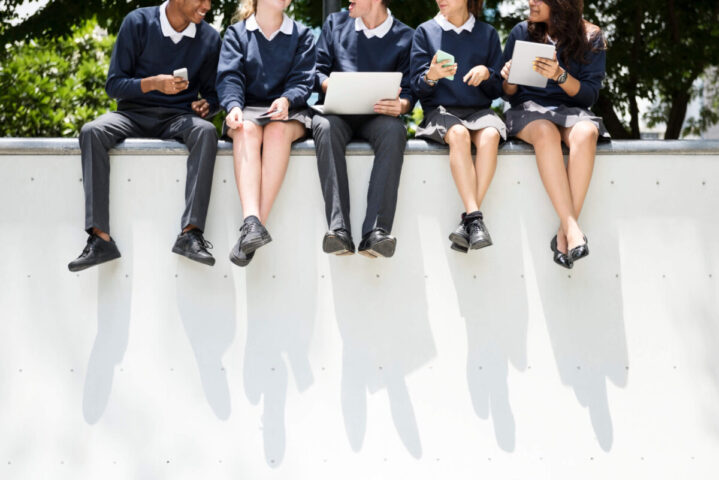
An amazing opportunity to reshape education
Schools are open in Thailand so everyone can breath a sigh of relief. Parents have stopped being unpaid substitute teachers, academic staff are no longer staring into screens and children can learn with their friends once more. But maybe this is more than a time for wanting everything to go back to the ways they were. This could just be the best of times to ask where schools should be going next. Lockdowns around the world have shown us that the imaginative and the resourceful thrive even in the face of adversity. Schools have taken a step forward by embracing the existing technology and shaping it to fit needs in an emergency. Now that the worst may be over schools should not stop or go backwards, they should be looking to the future.
Imagine going to sleep in 1995 and waking up in early in 2020. You might wonder why nobody was wearing baggy tops, what happened to grunge music or what fresh-faced teenager Leonardo di Caprio was doing these days. You may have read about a new idea called e-banking and wondered if banks had changed much while you were away. How you would react when you found you could do all your banking, your shopping and even run your business from a tiny pocket sized computer?
Banking is unrecognisiable from the 1990s as are so many of our industries and sectors. Banks have hardly any branches and the new ones have none at all. The world’s biggest taxi company owns no cars, the most popular media company creates no content, the world’s most valuable retailer carries no stock, the biggest accommodation provider owns no property and the owner of the largest selection of movies has no cinemas. In fact, banks don’t even hold a monopoly over regulating money now that cryptocurrencies, can be used without banks being involved at all.
So, dazed and confused by so much change, you might marvel at the crazy new world you had woken into. But if you visit a school it will look so familiar and hardly changed at all. Of course there is much more hardware and software and a greater focus on equality but these are not big changes compared to those outside the classroom. In fact the actual system of education doesn’t look very different today than it did way back in the 1950s. Students move along in same age groups, fixed by blocks of time all trying to learn the same material in the same way at the same pace. Most will write in the same kind of exercise books and sit the same kind of exams in rooms and in rows that have hardly moved on at all. It is an industrial factory style model, sorting by testing and grading, filtering out more and more the older the students become. This seemed to work half a century ago when there were career ladders in trades and apprenticeships that provided meaningful alternatives for those who did not make it to the top of the school pile. Now despite the fact that many of these routes have gone much of the actual education, supposed to be there to help young people, remains the same.
When Covid-19 forced millions to stay at home for work or study we all looked to tech for the answers. Thailand is ahead of many countries in getting children back into schools but few would claim with any confidence that this pandemic is over anywhere in the world. Once airports open up fully and there are more international visitors Thailand’s school may have to close again. Who can tell? Rather than wringing our hands and wishing things were different, this is the best time to rethink what a school should look like and how it should operate. This can be the dawn of the new era for schools and the time for technology to be embraced in a profound, forward thinking way.
The world’s big tech companies are already looking at this and investing heavily. They see a business opportunity as well as the chance to truly empower learning. The most advanced model has been developed by Microsoft and can be seen in its Showcase Schools, a new and growing initiative aimed at moving schools into the realm of high-tech, high-spec teaching and learning. If you ask as typical school if they have heard of Getting Smart, Gensler, Education Changemakers, Steelcase or Fielding Nair International they are unlikely to be familiar with them. Yet these are Microsoft’s collaborators in a radical rethink of what the classroom and the whole school could look like in the years ahead. They are pioneering new ideas, new approaches and new technology. Microsoft wants to offer an effective guide for education leaders to navigate the complexity of transforming schools. This is a holistic and systemic approach grounded in research from policy makers and academics around the world. It is about so much more than hardware.

So what might it look like? Imagine if every lesson in the school involved the integration of technology in to teaching not just a blackboard replaced by a whiteboard, video lessons on YouTube, online quizzes and Zoom but each child linked to all of their teachers through seamless online resources. Children have tablets instead of books and a digital pen/pencil. There are still lessons, classes, test and teachers but work can be exchanged, ideas shared and comments made digitally in real time. Students don’t all have to be in the same place or the same age but can collaborate and communicate either online or in person – whatever works. All books, notes, videos, links and resources are available all the time and students are doers not watchers, engaged not just looking. Everyone reads, writes, draws, annotates, watches and records. Teachers are not replaced; they are integrated into a wider, richer experience. The choice is not whether we use the teacher or the computer, because the answer is to both – all the time. If the class are together the lessons are great and if the class has to stay at home then they can carry on without interruption. A student’s work is their own and private but their learning world is open and safe.
This is not an educational utopia – it is happening at the moment in some schools round the world. Schools that have applied and been assessed before joining a new elite of schools that are forging ahead.
What makes them so different?
- The whole school community is committed to the future of digital transformation in education.
- All staff are trained and committed to working with cutting edge educational technology.
- Students and parents get on board and work with the school.
- The school invests in the necessary technology and licenses to get the job done.
- Schools lead and share innovation in education transformation in their local community and around the globe.
- Less hierarchical and traditional, more collaborative and open to change.
- The school staff are one team all working to the same end.
Banking moved from filling out forms and monthly statements to real time, online, fast moving payments and receipts. With this came a modern approach, new entrants to the market and bold, new thinking. Older banks fell away, staff stuck in the old ways struggled and those committed to the future thrived and grew. If the past is any guide to the future of progress it is unlikely that the green shoots of change will grow in government department anywhere in the world. The answer might not be in the hands of Microsoft or another big business, it may emerge somewhere smaller, somewhere unexpected and different. This is the model of change we see everywhere from Alibaba to Uber in every country.
Schools are not under threat and machines will never replace teachers but schools must adapt. The factory style industrial model of how we run society is collapsing in many sectors and it is about time the status quo is questioned and replaced in all our schools. There will probably be some resistance and a few false starts but we owe it to this and future generations of children to make sure learning is future proof and can never be interrupted again.
Peter Hogan has been the Head of schools in the UK and Asia for 20 years. He writes about schools, teaching and learning at hogan.education



